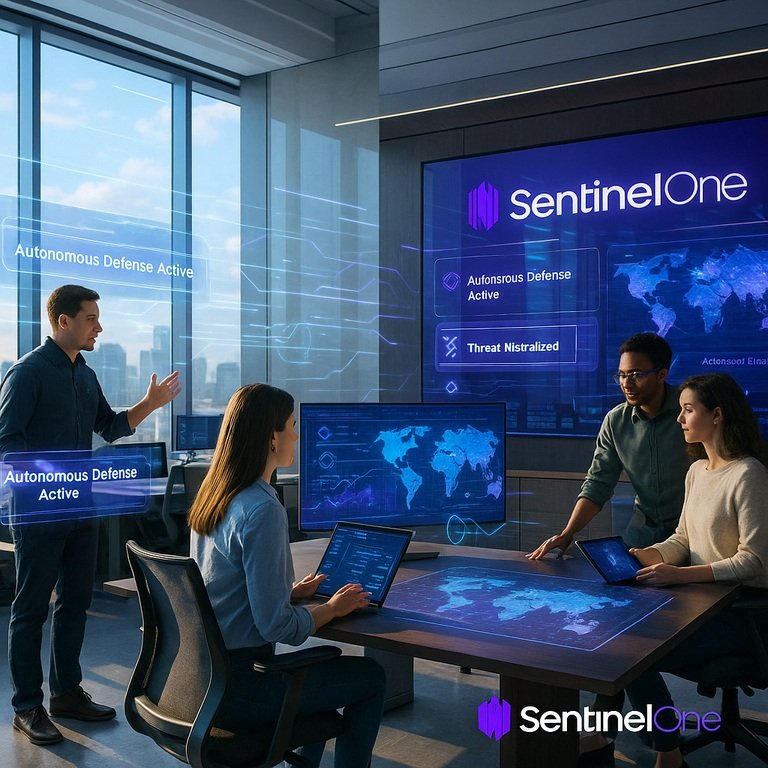Continue Reading With Our 7-Day Free Trial
SentinelOne shares surged as much as 18% on Monday, July 21, 2025, amid speculation that cybersecurity heavyweight Palo Alto Networks may be eyeing the smaller player for acquisition. Although the stock pared its gains later in the day, the buzz remained strong after Israeli media outlets, including Calcalist and Globes, reported that Palo Alto was in advanced discussions to purchase SentinelOne in a deal potentially valued at around $7 billion. Both companies declined to comment on market speculation, but investors took notice — especially as SentinelOne’s market cap hovers near $6 billion, while Palo Alto commands a significantly larger valuation of approximately $131 billion. This potential acquisition, if it materializes, could reshape the cybersecurity landscape by combining Palo Alto’s robust firewall and network security portfolio with SentinelOne’s AI-driven endpoint and cloud security capabilities. Below are the four key strategic drivers that may be influencing Palo Alto’s reported interest in SentinelOne.
AI-Driven Cybersecurity As A Strategic Growth Lever
One of the most compelling reasons for Palo Alto to pursue SentinelOne lies in the latter’s significant strides in AI-driven cybersecurity. SentinelOne has evolved its product suite beyond traditional endpoint detection and response (EDR), showcasing strong momentum in its Purple AI platform and agentic automation features. With Purple AI achieving triple-digit growth in Q1 FY26 bookings and over 25% attach rate across new subscriptions, SentinelOne is positioning itself as a key player in autonomous, real-time threat detection. Its agentic AI platform is capable of understanding context, orchestrating multistep responses, and remediating incidents autonomously, all of which are increasingly essential in today’s machine-speed threat landscape. Palo Alto, though a market leader in next-gen firewall and network security, has yet to dominate the endpoint AI domain at a comparable depth. SentinelOne’s recent product innovations such as Athena, Hyperautomation, and AI SIEM expand the definition of cybersecurity to include more holistic, data-centric, and real-time intelligence layers—areas where Palo Alto may be looking to accelerate its own growth. By acquiring SentinelOne, Palo Alto could fast-track its AI capabilities and consolidate its leadership across both network and endpoint security, delivering a more integrated defense system that appeals to modern enterprise buyers seeking unified platforms.
Cloud Security & CNAPP Integration Synergies
Another strategic rationale behind a possible acquisition is SentinelOne’s growing traction in the cloud security space, particularly through its Cloud-Native Application Protection Platform (CNAPP) suite. In Q1 FY26, SentinelOne introduced a unified Cloud Security suite that integrates cloud workload protection, posture management, detection and response, cloud identity, and AI-driven security analytics into a single AI-powered offering. This resonated with enterprise clients such as a Fortune 500 industrial company, who sought to close visibility gaps and reduce operational complexity compared to incumbent solutions. The unified cloud offering not only helped win marquee clients but also increased ARR per customer to record levels. Palo Alto Networks has its own Prisma Cloud platform but integrating SentinelOne’s AI-powered, real-time cloud security approach could enhance performance, reduce overlap, and create a more compelling solution for customers navigating multi-cloud environments. With increased competition from players like CrowdStrike and Microsoft, a SentinelOne acquisition would bolster Palo Alto’s ability to offer a differentiated, high-performing CNAPP alternative. The synergy would lie in combining Prisma’s scalability and platform breadth with SentinelOne’s modern analytics backend and AI posture management, positioning Palo Alto to capture more enterprise cloud workloads, especially in the mid-market and federal sectors.
Enhanced Federal Market Access Via Fedramp Certifications
SentinelOne has made notable inroads into the U.S. federal cybersecurity market, and this could be a major driver for Palo Alto’s interest. The company recently achieved FedRAMP High authorization for its Purple AI, CNAPP, and Hyperautomation capabilities—making Purple the first and only agentic AI solution approved for use in U.S. government environments. These certifications significantly reduce procurement friction and demonstrate compliance with the highest federal security standards, positioning SentinelOne as a credible vendor for sensitive, large-scale federal projects. Palo Alto, while already a strong federal player, could benefit from a complementary platform that allows for deeper integration of AI-first capabilities within federal agencies. SentinelOne’s ability to win seven-figure expansion deals with federal agencies, as noted in early Q2, underscores its rising credibility in this vertical. Combining SentinelOne’s advanced endpoint and AI certifications with Palo Alto’s established federal network security presence could allow the combined entity to offer comprehensive, compliant, and modern solutions tailored for government needs. Moreover, SentinelOne’s efforts to align with federal budget timelines and funding cycles demonstrate a mature understanding of the public procurement process, which could further accelerate sales velocity under Palo Alto’s broader sales and contracting infrastructure.
Financial Profile & Growth Efficiency Enhancing Shareholder Value
SentinelOne has shown strong financial discipline and efficiency metrics that could make it an attractive acquisition target. In Q1 FY26, the company reported 23% year-over-year revenue growth, a gross margin of 79%, and a record free cash flow margin of 20%, alongside a fourth consecutive quarter of positive net income. The company also ended the quarter with $1.2 billion in cash and investments and announced a $200 million share repurchase program—an indication of confidence in its long-term value. While net new ARR in Q1 was softer due to macro volatility and elongated sales cycles, management expressed optimism around Q2 acceleration and cited improved trends in May. The strategic shift toward a platform-first go-to-market approach, as opposed to siloed product sales, is expected to yield higher average deal sizes, longer contract durations, and broader cross-sell opportunities across endpoint, cloud, and data solutions. From Palo Alto’s perspective, SentinelOne’s shift toward operational efficiency, bundled with solid mid-market and large enterprise traction, offers an opportunity to fold in a high-performing but smaller-scale business that complements Palo Alto’s existing structure. The acquisition could also mitigate competitive risk by eliminating a rising challenger while simultaneously boosting top-line growth and long-term operating margin expansion.
Key Takeaways
While SentinelOne offers Palo Alto a highly complementary mix of advanced AI capabilities, cloud-native security platforms, federal certifications, and a strong financial profile, there are important considerations that may influence whether a deal actually materializes. Integration risks, overlap with existing platforms, pricing pressures, and the unpredictable macroeconomic backdrop could all complicate the path forward. Additionally, SentinelOne’s move toward platform bundling and broader GTM evolution is still in progress, and it remains to be seen how well the strategy will scale under Palo Alto’s operational umbrella. Nevertheless, from a strategic and technological standpoint, the synergies between the two companies are clear, and an acquisition could create one of the most comprehensive cybersecurity platforms in the market. Whether these theoretical synergies translate into an actionable M&A outcome will depend on both boardroom dynamics and broader market sentiment in the coming months.





